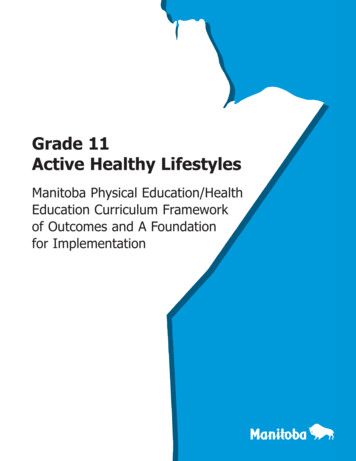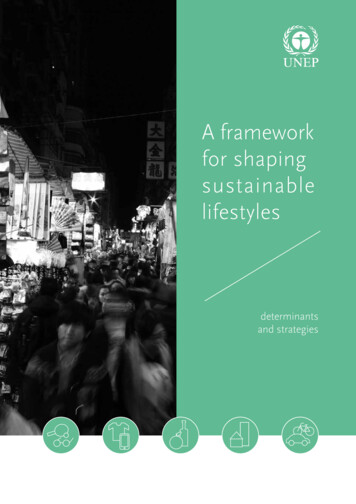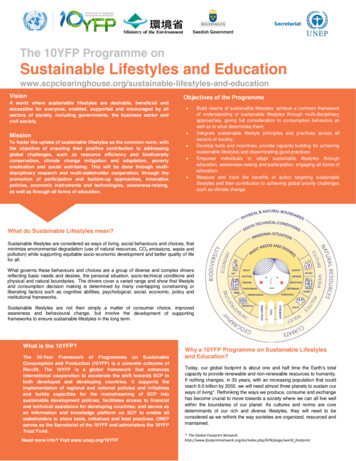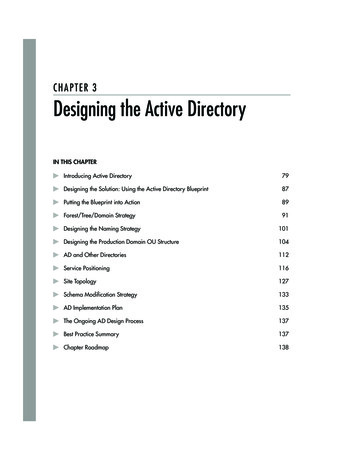
Transcription
Grade 11Active Healthy LifestylesManitoba Physical Education/HealthEducation Curriculum Frameworkof Outcomes and A Foundationfor Implementation
GRADE 11A C T I V E H E A LT H Y L I F E S TY L E SManitoba Physical Education/Health EducationCurriculum Framework of Outcomes andA Foundation for Implementation2008Manitoba Education, Citizenship and Youth
Manitoba Education, Citizenship and Youth Cataloguing in Publication Data613.071Grade 11 active healthy lifestyles : Manitobaphysical education/health education curriculumframework of outcomes and a foundation forimplementationIncludes bibliographical references.ISBN-13: 978-0-7711-4016-71. Physical education and training—Manitoba—Curricula. 2. Health education—Manitoba—Curricula. 3.Physical education and training—Study and teaching(Secondary)—Manitoba. 4. Health education (Secondary)—Manitoba. I. Manitoba. Manitoba Education, Citizenship andYouth.Manitoba Education, Citizenship and YouthSchool Programs DivisionWinnipeg, Manitoba, CanadaEvery effort has been made to acknowledge original sources and to comply withcopyright law. If cases are identified where this has not been done, please notifyManitoba Education, Citizenship and Youth. Errors or omissions will be correctedin a future edition. Sincere thanks to the authors and publishers who allowedtheir original material to be used.All images found in this document are copyright protected and should not beextracted, accessed, or reproduced for any purpose other than for their intendededucational use in this document.Any websites referenced in this document are subject to change without notice.Educators are advised to preview and evaluate websites and online resourcesbefore recommending them for student use.Print copies of this resource can be purchased from the Manitoba TextBook Bureau (stock number 80594). The print version of this resource isaccompanied by a CD-ROM that includes a copy of this curriculumdocument, along with other policy and support documents. The CD-ROMcan also be purchased separately (stock number 80599). Order online at www.mtbb.mb.ca .This resource is also available on the Manitoba Education, Citizenship andYouth website at www.edu.gov.mb.ca/k12/cur/physhlth/curriculum.html .Ce document est disponible en français.
ckground1Document Content and Organization3Overview of Grade 11 Active Healthy LifestylesFramework Overview79Key Characteristics from the Framework Reinforced in Grade 119Policy for Implementing Grades 11 and 12 Physical Education/Health Education12Planning for Implementation21Guiding Principles21Guidelines for Implementation22Specific Learning Outcomes32Grade 11 Active Healthy Lifestyles—Specific Learning Outcomes32Physical Activity Practicum33Core Component34Implementation Overview37Grades 11 and 12 Philosophy for Effective Programming37Connections between the General Learning Outcomes and theModules38Planning for Instruction43Planning Guidelines and Tools43Active Learning Strategies43Assessment and Reporting45Purposes of Assessment46Determining Course Completion49Contentsiii
Modules for Physical Activity Practicum and ComponentIntroduction61Guide to Reading the Modules and Lessons61Module A: Physical Activity Practicum67Specific Learning Outcomes68Introduction69Lesson 1: Personal Physical Activity Inventory71Lesson 2: Managing Risks Related to Physical Activity79Lesson 3: Implementing the Safety and Physical Activity Plan91Module B: Fitness Management103Specific Learning Outcomes104Introduction105Lesson 1: Physical Activity for Optimal Health and Fitness107Lesson 2: Changing Physical Activity Behaviour113Lesson 3: Understanding Your Personal Motivation forPhysical Activity123Lesson 4: Addressing Barriers to Physical Activity137Lesson 5: Making Physical Activity a Habit145Lesson 6: Planning for Physical Fitness161Module C: Mental-Emotional Health185Specific Learning Outcomes186Introduction187Lesson 1: Mental Health, Health Habits, and Exercise189Lesson 2: Stress and Body Image205Lesson 3: Anxiety and Depression225Module D: Social Impact of Sport237Specific Learning Outcomes238Introduction239Lesson 1: The Roles of Sport241Lesson 2: Sport as an Agent for Social Change251Lesson 3: Sporting Behaviour265Module E: Substance Use and Abuse Preventioniv59275Specific Learning Outcomes276Introduction277Lesson 1: Legal and Illegal Substances279Lesson 2: Stages of Substance Use and Addiction293Lesson 3: Risks and Consequences of Substance Use303Lesson 4: Advocacy against Substance Use and Abuse333Grade 11 Active Healthy Lifestyles
Appendices351Appendix A: Curriculum Map for Grades 11 and 12 Active HealthyLifestyles353Appendix B: Grade 11 Active Healthy Lifestyles Curriculum Matrix355Appendix C: Specific Learning Outcomes for Grade 11 Active HealthyLifestyles359Appendix D: Planning Guidelines for Physical Education/Health Education363Appendix E: Active Learning Strategies379Appendix F: Sample Assessment Tools and Checklists387Appendix G: Common Planning Tools and Forms395Bibliography407Contentsv
ACKNOWLEDGEMENTSManitoba Education, Citizenship and Youth gratefully acknowledges the contributions of thefollowing individuals in the development of Grade 11 Active Healthy Lifestyles: Manitoba PhysicalEducation/Health Education Curriculum Framework of Outcomes and A Foundation forImplementation.WriterContent ReviewersNick DyckPhysical Education and Health ConsultantPembina Trails School DivisionDr. Catherine CaseyAssistant ProfessorFaculty of EducationUniversity of ManitobaDr. Shannon GanderPolicy AnalystMental Health and Addictions BranchManitoba Health and Healthy LivingDr. Dean KreillarsProfessorSchool of Medical RehabilitationUniversity of ManitobaNicole LapingPrevention andEducation ConsultantYouth Community-Based ServicesAddictions Foundation of ManitobaFaralee WilsonManitoba Physical Education Teachers AssociationSchools Physical Activity (MPETA)CoordinatorMembers of theManitoba Grades11 and 12Physical Education/Health EducationDevelopment TeamDavid BardConsultantWinnipeg School DivisionDaniel Bélisle(until June 2007)École Saint-JoachimDivision scolaire franco-manitobaineShawna CochraneThomsonPortage Collegiate InstitutePortage la Prairie School DivisionDemetro DanylukSt. Mary’s AcademyIndependent SchoolJoanne GoodwinVincent Massey CollegiatePembina Trails School DivisionJason MateychukRoseau Valley SchoolBorderland School DivisionJohn PotterMinnedosa CollegiateRolling River School DivisionRobert StannersCollège Louis-RielDivision scolaire franco-manitobaineLynne Syrenne-HabeckCollège Jeanne-SauvéLouis Riel School DivisionAcknowledgementsvii
Members of theManitoba Grades11 and 12Physical Education/Health EducationDevelopment Team(Continued)Treva Tilston-JonesMurdoch MacKay CollegiateRiver East Transcona School DivisionJody WilliamsSwan Valley Regional Secondary SchoolSwan Valley School DivisionJamie WilsonJoe A. Ross SchoolIndividual Band Operated SchoolOpaskwayak Education AuthoritySteering Committee(Members as of2006/2007 and2007/2008)Terry BobychukSenior Years RepresentativeSeven Oaks School DivisionCatherine Casey(from September 2007)Faculty of EducationUniversity of ManitobaWendy CullMiddle Years RepresentativeKelsey School DivisionNick DyckManitoba Physical Education Supervisors’Association (MPESA)Pembina Trails School DivisionRon Hildebrand(until June 2007)Manitoba Association of School Superintendents(MASS)Dwight KearnsEarly Years RepresentativeBrandon School DivisionPeter KotykManitoba Association of School Trustees (MAST)Khalid MahmoodManitoba Association of Parent Councils (MAPC)Pat McCarthy-BriggsAgencies for School Health (ASH)Ross Metcalfe(from September 2007)Manitoba Association of School Superintendents(MASS)Francine Morin(until June 2007)Faculty of EducationUniversity of ManitobaLaura MorrisonManitoba Healthy SchoolsHealthy LivingIrene NordheimCouncil of School Leaders (COSL)Jacki Nylen(from September 2007)Manitoba Physical Education Teachers Association(MPETA)viiiGrade 11 Active Healthy Lifestyles
Manitoba Education,Citizenship and YouthSchool ProgramsDivision andBureau de l’éducationfrançaise DivisionStaffJean-Vianney AuclairBureau de l’éducation française DivisionAssistant Deputy Minister Manitoba Education, Citizenship and YouthLee-Ila BotheCoordinatorDocument Production ServicesEducational Resources BranchJacques DorgeActing DirectorCurriculum Development and Implementation BranchBureau de l’éducation française DivisionCécile DufresneConsultant(until February 2007)Curriculum Development and Implementation BranchBureau de l’éducation française DivisionDarryl GervaisCoordinatorDevelopment UnitInstruction, Curriculum and Assessment BranchSurujdai GorcharanAdministrative AssistantDevelopment UnitInstruction, Curriculum and Assessment BranchSusan LetkemannPublications EditorDocument Production ServicesEducational Resources BranchJanet LongDesktop PublisherDocument Production ServicesEducational Resources BranchAnne LongstonSchool Programs DivisionAssistant Deputy Minister Manitoba Education, Citizenship and YouthGrant McManesProject Co-leader/Consultant(after September 2007)Development UnitInstruction, Curriculum and Assessment BranchAileen NajduchDirectorInstruction, Curriculum and Assessment BranchSchool Programs DivisionPaul PaquinConsultant(after February 2007)Curriculum Development and Implementation BranchBureau de l’éducation française DivisionCyril ParentDesktop PublisherDocument Production ServicesEducational Resources BranchLindsay WalkerDesktop PublisherDocument Production ServicesEducational Resources BranchHeather WilloughbyProject Co-leader/ConsultantDevelopment UnitInstruction, Curriculum and Assessment BranchAcknowledgementsix
INTRODUCTIONPurposeGrade 11 Active Healthy Lifestyles: Manitoba Physical Education/Health Education CurriculumFramework of Outcomes and A Foundation for Implementation is a combined Framework andImplementation document. The purpose of this document is to provide Manitoba schooladministrators and teachers with the basis for curriculum planning, teaching, learning,and assessment.The print version of Grade 11 Active Healthy Lifestyles is accompanied by a CD-ROM,which contains a copy of this curriculum document, as well as other policy and supportdocuments. The curriculum document is also available on the Manitoba Education,Citizenship and Youth website at www.edu.gov.mb.ca/k12/cur/physhlth/curriculum.html .BackgroundThe resources that influenced the direction and content of the Grade 11 Active HealthyLifestyles curriculum include the documents cited below. Other resources are cited in theBibliography.Resources Used in Curriculum DocumentReportsHealthy Kids, Healthy Futures All-Party Task Force. Healthy Kids, Healthy Futures: Task Force Report. Winnipeg,MB: Manitoba Healthy Living, June 2005. Available online at www.gov.mb.ca/healthykids/ .Proactive Information Services Inc., and Manitoba Education, Citizenship and Youth. Helping Clients Make aDifference: S3 and S4* Physical Education/Health Education Consultation, Final Report. Winnipeg, MB:Proactive Information Services Inc., June 2006. Available online at www.edu.gov.mb.ca/k12/docs/reports/s3 s4 ph/ .Departmental ResourcesManitoba Education and Training. Kindergarten to Senior 4* Physical Education/ Health Education: ManitobaCurriculum Framework of Outcomes for Active Healthy Lifestyles. Winnipeg, MB: Manitoba Education andTraining, 2000. Referred to as the Framework.** Manitoba Education, Citizenship and Youth. Guidelines for Fitness Assessment in Manitoba Schools: A Resourcefor Physical Education/Health Education. Winnipeg, MB: Manitoba Education, Citizenship and Youth, 2004.** ---. Implementation of Grades 11 and 12 Physical Education/Health Education: A Policy Document. Winnipeg, MB:Manitoba Education, Citizenship and Youth, 2007. Referred to as the Policy Document.---. OUT-of-Class Safety Handbook: A Resource for Grades 9 to 12 Physical Education/Health Education.Winnipeg, MB: Manitoba Education, Citizenship and Youth, 2008.** ---. Senior 1 and Senior 2* Physical Education/Health Education: A Foundation for Implementation. Winnipeg, MB:Manitoba Education, Citizenship and Youth, 2004.These departmental resources are available online at www.edu.gov.mb.ca/k12/cur/physhlth/curriculum.html .Safety-Related ResourcesHanna, Glenda, Quest Research and Consulting Inc., and YouthSafe Outdoors (Association). YouthSafe Manitoba:School Field Trip Resource. Edmonton, AB: Quest Research and Consulting, 2004.** Manitoba Physical Education Teachers Association (MPETA), et al. Safety Guidelines for Physical Activity inManitoba Schools. Winnipeg, MB: MPETA, 2000. Available online at www.edu.gov.mb.ca/k12/docs/support/pehe safety/ .*In June 2006 the terms Grade 9, 10, 11, 12 were reinstated to replace Senior 1, 2, 3, 4 high school designations.**These resources are available on the CD-ROM that accompanies this document.I n t r o d u c t i o n 1
Research and ConsultationsHealthy Kids, Healthy Futures: Task Force Report identifies 47 recommendations to improvethe health and well-being of Manitoba’s children and youth, which have been accepted bygovernment. Three of these recommendations address high school physical education/health education (PE/HE). The report recommends thatthe provincial government not just recommend, but mandate the current amountof time that [Grades 9 and 10] students spend in [PE/HE] classes. Schools canchoose to meet the mandated times within the timetable, or use an out-ofclassroom model for up to 20 hours of the mandated 110 hours. This should beimplemented before the fall of 2007. . . develop a [PE/HE] curriculum for [Grades 11 and 12] students. This should beimplemented before the fall of 2008. . . require all [Grades 11 and 12] students to complete two [PE/HE] credits forgraduation, in addition to the two credits required in [Grades 9 and 10]. Schoolsmay choose to include the [PE/HE] credits in the timetable or use an out-ofclassroom model. (24–25)Furthermore, the Healthy Kids, Healthy Futures: Task Force Report encourages parents,*students, and schools to “work together to determine what will work best in theircommunity to help youth take greater ownership of their own physical fitness, promotethe discovery of activities suited to their own individual interests, and encourage activelifestyles that persist into their futures” (25).The choice of using an OUT-of-class model was provided to help minimize the timestudents spend away from academic studies and to give families, students, and schoolsmore options in their efforts to increase physical activity among young people. As well,local recreation and sports-related organizations are encouraged to explore how nearbyschools and community facilities could be jointly used.The development of the Grade 11 Active Healthy Lifestyles curriculum was also guidedby research and consultations. As reported in Helping Clients Make a Difference: S3 and S4Physical Education/Health Education Consultation, Final Report (4) , the delivery model mostfavoured by students and educators was a flexible delivery model that would allowschools and/or students to choose different combinations of IN-class and OUT-of-classtime to achieve credits. This flexibility was considered important since resources such asfacilities, equipment, staffing, and timetabling challenges vary from school to school.*2In this document the term parents refers to both parents and guardians and is used with the recognition that in somecases only one parent may be involved in a child’s education. G r a d e1 1A c t i v eH e a l t h yL i f e s t y l e s
Policy for Grades 11 and 12 PE/HEIn April 2007 Manitoba Education, Citizenship and Youth released Implementation ofGrades 11 and 12 Physical Education/Health Education: A Policy Document. This PolicyDocument serves as the basis for the development of, and provides direction for theimplementation of, the Grades 11 and 12 PE/HE curricula. A development teamcomposed of Manitoba educators was formed to work in collaboration with ManitobaEducation, Citizenship and Youth to produce the Grade 11 Active Healthy Lifestylescurriculum.Kindergarten to Senior 4 Physical Education/ Health Education: Manitoba Curriculum Frameworkof Outcomes for Active Healthy Lifestyles (the Framework) identifies the five general learningoutcomes and provides the basis for teaching, learning, and assessment in PE/HE for allgrades. Because the Framework identifies the specific learning outcomes only forKindergarten to Grade 10, this Grade 11 Active Health Lifestyles document includes newinformation related to specific learning outcomes and guidelines for implementationspecifically for Grade 11.Document Content and OrganizationGrade 11 Active Healthy Lifestyles contains the following sections: Introduction: The Introduction outlines the purpose, background, and content andorganization of this document. Overview of Grade 11 Active Healthy Lifestyles: This section gives an overview ofthe following: Framework Overview: This section contains key information from the Frameworkthat pertains to Grade 11 Active Healthy Lifestyles. It also contains the new policyinformation related to mandating Grades 11 and 12 PE/HE, including a discussionof graduation requirements, potentially sensitive content, involvement of parents,families, and communities, students with exceptional learning needs and/orspecial health care needs, and safety and liability. Planning for Implementation: This section outlines the guiding principles,requirements, and guidelines for implementing Grade 11 Active HealthyLifestyles, based on the Policy Document, for the three PE/HE components:Physical Activity Practicum, Core Component, and Flexible Delivery Component. Specific Learning Outcomes: The specific learning outcomes identified forGrade 11 Active Healthy Lifestyles are presented by module in this section.Specific learning outcomes drive instruction and assessment for all students. Implementation Overview: This section discusses the philosophy for effectiveprogramming in Grades 11 and 12 PE/HE and outlines how the Grade 11 ActiveHealthy Lifestyles curriculum is connected to each of the general learningoutcomes identified in the Framework.I n t r o d u c t i o n 3
Planning for Instruction: This section refers to general information on planningfor instruction that appears in the Overview of Senior 1 and Senior 2 [Grades 9 and10] Physical Education/Health Education: A Foundation for Implementation but alsoapplies to Grades 11 and 12 PE/HE. More detailed information is provided inAppendix D: Planning Guidelines for Physical Education/Health Education. Assessment and Reporting: This section identifies how students will be graded forcompletion of the Grades 11 and 12 PE/HE courses using complete/incompletedesignations. It also discusses the purposes of assessment and providessuggestions for teachers to establish criteria for the compulsory personal fitnessportfolio, as well as suggestions on how teachers could assess student achievementof the learning outcomes in the Core Component modules. Modules for Physical Activity Practicum and Core Component: This section containsthe modules for the Physical Activity Practicum and the Core Component of thiscurriculum: Module A: Physical Activity Practicum Module B: Fitness Management Module C: Mental-Emotional Health Module D: Social Impact of Sport Module E: Substance Use and Abuse PreventionThe modules are units of instruction developed for a specific strand and/orcomponent of the curriculum. Each module presents lessons that identify the specificlearning outcomes, key understandings, and essential questions, provide backgroundinformation, offer suggestions for instruction/assessment, and present references toassist teachers with planning for instruction. Many references are websites, which arehyperlinked on the CD-ROM and online versions of the document. Resources Masters(RMs) are included at the end of most lessons. Teachers may use the sample lessonsand/or adjust them as locally determined. All modules are available in Word format. Appendices: The following appendices provide additional information and tools forplanning, teaching, and assessment: Appendix A: Curriculum Map for Grade 11 and Grade 12 Healthy ActiveLifestyles Appendix B: Grade 11 Active Healthy Lifestyles Curriculum Matrix Appendix C: Specific Learning Outcomes for Grade 11 Active Healthy Lifestyles Appendix D: Planning Guidelines for Physical Education/Health Education Appendix E: Active Learning Strategies Appendix F: Sample Assessment Tools and Checklists Appendix G: Common Planning Tools and Forms4 G r a d e1 1A c t i v eH e a l t h yL i f e s t y l e s
Bibliography: The print and online resources used in developing this document arecited in the Bibliography. CD-ROM: The CD-ROM that accompanies this document contains a copy of Grade 11Active Healthy Lifestyles, along with other policy and support documents that apply tothis curriculum.NOTEABOUTCOPYRIGHTPlease note that this document contains copyright-protected materials (images and text) thathave been reproduced or adapted from a variety of other sources. Manitoba Education,Citizenship and Youth has obtained permission to use these materials in this document and hasmade every effort to acknowledge the original sources. These materials should not be extracted,accessed, reproduced, or adapted for any purpose other than for their intended educational usein this document.I n t r o d u c t i o n 5
OVERVIEW OF GRADE 11ACTIVE HEALTHY LIFESTYLESFramework OverviewPlanning for ImplementationSpecific Learning OutcomesImplementation OverviewPlanning for InstructionAssessment and Reporting
OVERVIEW OF GRADE 11 ACTIVE HEALTHYLIFESTYLESFramework OverviewThe Framework was the basis for the development of the Grade 11 Active HealthyLifestyles curriculum. This Framework Overview highlights key characteristics from theFramework that are reinforced in Grade 11, as well as changes to address the policy forimplementing Grades 11 and 12 PE/HE.Key Characteristics from the Framework Reinforced in Grade 11The Grade 11 Active Healthy Lifestyles curriculum continues to support the vision andaim identified for Kindergarten to Grade 12 PE/HE in the Framework: Vision: The vision is physically active and healthy lifestyles for all students. Aim: The aim is to provide students with planned and balanced programming todevelop the knowledge, skills, and attitudes for physically active and healthylifestyles. (3)As highlighted in the Framework,The Centres for Disease Control and Prevention (1997), supported by the CanadianFitness and Lifestyle Research Institute, identify the significant behaviours thatcontribute to today’s major health issues: inadequate physical activity unhealthy dietary behaviours drug use, including alcohol and tobacco sexual behaviours that result in sexually transmitted diseases/infections andunintended pregnancies behaviours that result in intentional and unintentional injuries (5)The Grade 11 Active Healthy Lifestyles curriculum also addresses these five major healthrisk areas for children and youth.O v e r v i e w 9
The Conceptual FrameworkThe content of both subject areas, PE and HE, is integrated and organized within fiveinterrelated general learning outcomes, as illustrated in the following ConceptualFramework.** Source: Manitoba Education and Training. Kindergarten to Senior 4 Physical Education/Health Education: ManitobaCurriculum Framework of Outcomes for Active Healthy Lifestyles. Winnipeg, MB: Manitoba Education and Training, 2000. 21.This Venn diagram captures many of the key characteristics and principles related toPE/HE. For example, PE/HE builds on the foundation skill areas (i.e., literacy andcommunication, human relations, problem solving, and technology), as well as on theelements for integration (i.e., curriculum integration, human diversity, sustainabledevelopment, anti-racist/anti-bias education, resource-based learning, differentiatedinstruction, Aboriginal perspectives, gender fairness, appropriate age portrayals). Thediagram shows how the two subject areas PE and HE are connected through the fivegeneral learning outcomes. The curriculum focus is student-centred, with each studentlearning the knowledge, skills, and attitudes for a physically active and healthy lifestyle.The five general learning outcomes and attitude indicators identified in the Framework areaddressed in PE/HE across all grades from Kindergarten to Grade 12. Refer to thefollowing chart for the descriptions of each general learning outcome and thecorresponding attitude indicators.10 G r a d e1 1A c t i v eH e a l t h yL i f e s t y l e s
Kindergarten to Grade 12 Physical Education/Health EducationGeneral Learning Outcomes and Attitude Indicators*General Learning Outcomes1Attitude IndicatorsMovementThe student will demonstratecompetency in selected movementskills, and knowledge of movementdevelopment and physical activitieswith respect to different types of learningexperiences, environments, and cultures.2The student will demonstrate the abilityto develop and follow a personal fitnessplan for lifelong physical activity andwell-being.3SafetyThe student will demonstrate safe andresponsible behaviours to manage risksand prevent injuries in physical activityparticipation and in daily living.4Personal and Social ManagementThe student will demonstrate theability to develop selfunderstanding, to make healthenhancing decisions, to workcooperatively and fairly with others,and to build positive relationships with others.5Healthy Lifestyle PracticesThe student will demonstrate theability to make informed decisions forhealthy living related to personalhealth practices, active living, healthynutritional practices, substance useand abuse, and human sexuality.Specific Learning OutcomesFitness Management1.1Show a willingness to participate in a variety ofphysical activities.1.2Express enjoyment in a variety of movementexperiences.1.3Appreciate that time, commitment, and practiceare required for skill development.1.4Appreciate the aesthetic and athletic values ofmovement.1.5Appreciate and respect diversity while participatingin physical activity.1.6Appreciate and respect the natural environmentwhile participating in physical activity.2.1Show an interest in and responsibility for personalfitness.2.2Appreciate the role and contribution of regularparticipation in physical activity for health andfitness.2.3Show respect and acceptance for physical andperformance limitations of self and others.3.1Show respect for safety of self and others.3.2Show responsibility in following rules andregulations in dealing with safety of self andothers.4.1Show a positive attitude toward learning, growth,and personal health.4.2Be sensitive to the needs and abilities of others.4.3Demonstrate personal responsibility in daily workand play.4.4Show a willingness to play fairly and workcooperatively/collaboratively with others.4.5Show a positive attitude toward change.4.6Enjoy participation and learning.5.1Appreciate and value the benefits of healthylifestyle practices for a healthy body.5.2Appreciate the importance of making healthenhancing decisions in daily living.5.3Appreciate the responsibilities and commitmentassociated with developing healthy relationships.*Source: Manitoba Education and Training. Kindergarten to Senior 4 Physical Education/Health Education: Manitoba CurriculumFramework of Outcomes for Active Healthy Lifestyles. Winnipeg, MB: Manitoba Education and Training, 2000.O v e r v i e w 11
The Curriculum MapIn the Framework, a Curriculum Map (20) identifies all the strands that are addressed in allor some of the grades. As the Grades 11 and 12 curricula were developed, key strand areaswere selected and specific modules were developed to expand on the learning outcomesidentified for Grade 9 and/or Grade 10. For example, the Substance Use and AbusePrevention strand was developed further in Grade 11 to build on the knowledge, skills,and attitudes learned in previous grades.New topics were also chosen for Grade 11 that connected to existing strands. For example,Module D: Social Impact of Sport is a link to and an extension of the Social Developmentstrand. To see how the Grades 11 and 12 curricula connect with the strands or topics in theCurriculum Map presented in the Framework, refer to Appendix A: Curriculum Map forGrade 11 and Grade 12 Active Healthy Lifestyles at the end of this document. (The strandsthat appear in CAPS are addressed in both grades or only in one grade, as specified.)Policy for Implementing Grades 11 and 12 Physical Education/HealthEducationThe information from the Framework that required updating for Grades 11 and 12 PE/HErelates to the following areas: graduation requirements potentially sensitive content involvement of parents, families, and communities students with exceptional learning needs and/or special health care needs safety and liabilityThese areas are addressed below.Graduation RequirementsPhysical education/health education (PE/HE) is a compulsory subject area from Grades 9to 12, effective September 2008. In 2008/2009, students are required to graduate with aminimum of 29 credits, which must include three PE/HE credits. Beginning in 2009/2010,students are required to graduate with a minimum of 30 credits, which must include fourPE/HE credits.Grades 11 and 12 students will be graded for completion of courses usingcomplete/incomplete designations rather than percentages. Grades 11 and 12 PE/HEcredits will not be compulsory for Mature Student graduation.12 G r a d e1 1A c t i v eH e a l t h yL i f e s t y l e s
The following chart indicates the timeline for phasing in the PE/HE credits.Timeline for Phasing in PE/HE CreditsYearRegulation2008/2009Transition YearStudents will be required to graduate with a m
Module B: Fitness Management 103 Specific Learning Outcomes 104 Introduction 105 Lesson 1: Physical Activity for Optimal Health and Fitness 107 Lesson 2: Changing Physical Activity Behaviour 113 Lesson 3: Understanding Your Personal Motivation for Physical Activity 123 Lesson 4: Addressing Barriers to Physical Activity 137










